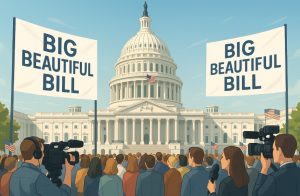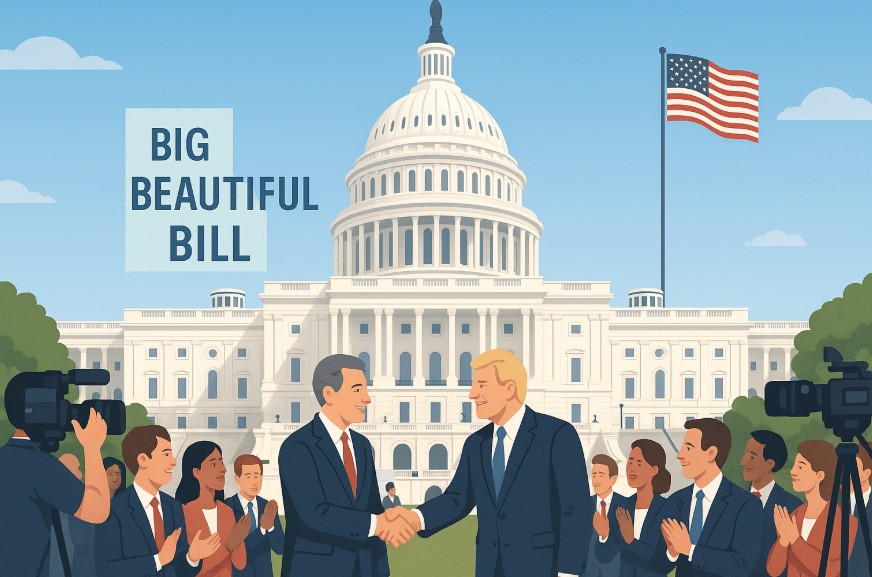The political world is buzzing, and you’ve probably seen the phrase “big beautiful bill” trending across headlines and social media in Canada. This isn’t just another piece of American legislation. It’s an ambitious package backed by former President Donald Trump, aiming to reshape nearly every corner of U.S. domestic policy.
From tax reforms to healthcare cutbacks, it’s packed with controversial provisions that have sparked both celebration and outrage. For Canadians, it raises critical questions: How could this massive American policy package impact us north of the border? What exactly does the bill entail?
As Canada’s largest trading partner enacts sweeping changes, understanding this bill is essential. Whether you’re a business owner watching trade dynamics or just politically curious, here’s what you need to know about what is happening with the big beautiful bill and why Canadians should be paying close attention.
Why Is Everyone Talking About the Big Beautiful Bill?

The term “Big Beautiful Bill” isn’t a random phrase, it’s been strategically used by Donald Trump to brand his most extensive legislative victory of his second term.
Designed to grab attention, the name captures the spirit of what Trump is pitching as his “golden age” reform. This massive bill was not only passed in time for a symbolic signing on July 4th, but it also represents the culmination of long-standing conservative objectives.
Here’s why it’s making waves:
- It’s a multi-trillion-dollar package touching taxes, defence, immigration, and healthcare.
- The name itself echoes Trump’s earlier campaign promises to “Make America Great Again.”
- It passed narrowly, with only two Republicans breaking ranks, showing deep divides even within the GOP.
- Trump is calling it the biggest tax cut in U.S. history and the ultimate fulfillment of his economic promises.
The buzz is also amplified by the high-stakes drama in Congress, where the bill nearly collapsed due to internal Republican disputes. From record-breaking speeches to party infighting, this was not a smooth journey, but it ended with the legislative win Trump had been fighting for.
What Is the One Big Beautiful Bill Act All About?
The One Big Beautiful Bill Act (OBBBA) is more than just a tax plan, it’s an all-encompassing political statement. This legislative package spans more than 800 pages and includes a wide array of structural reforms affecting economic policy, social services, and federal funding.
Key components include:
- Extending the 2017 tax cuts permanently, especially for corporations and high-income households.
- Introducing “Trump Accounts,” tax-free savings accounts created at a child’s birth.
- A $4.5 trillion cost, mostly funded through deep cuts to Medicaid, food stamps, and clean energy initiatives.
- A $6,000 deduction for older Americans earning less than $75,000 annually.
- Boosts in military funding and border security, including $150 billion each for both.
The OBBBA sets a tone of economic nationalism and austerity. It’s pitched as a growth strategy but has been criticised as a tax giveaway to the wealthy, paid for by cutting lifelines for vulnerable communities.
How Did the Big Beautiful Bill Pass Through the U.S. House?

When you ask what is happening with the big beautiful bill right now, a big part of the answer lies in how it managed to pass. The journey from proposal to passage was anything but easy.
Voting Timeline and Congressional Breakdown
The House approved the bill with a tight 218 to 214 vote on July 3, just in time for Trump’s planned Fourth of July signing. The Senate passed it days earlier with a 51-50 vote, requiring a tie-breaker from Vice President JD Vance.
Political Reactions from Democrats and Republicans
- Democrats called it the “big ugly bill,” accusing it of cruelty to the working class.
- Republican Speaker Mike Johnson praised it as a unifying conservative victory.
- Only two Republicans, Brian Fitzpatrick and Thomas Massie, voted against it.
Role of Trump’s Influence on Republican Lawmakers
Trump’s stronghold on the Republican Party was clear. He praised leaders like Mike Johnson and Steve Scalise for rallying support and reportedly convinced holdouts with promises of policy influence, not backroom deals. His political sway made the bill too big to fail, even among sceptics in his party.
In the end, partisan lines held strong. Despite fierce opposition, Trump’s political machine ensured the bill’s passage, turning it into a defining legislative moment of his presidency.
What Are the Main Provisions of the Big Beautiful Bill?
The bill spans a wide legislative landscape. Each section targets a core part of Trump’s conservative platform.
Tax Reforms
- Permanent extension of 2017 tax cuts
- $6,000 deduction for older Americans
- Tax breaks for tips and overtime
- Raised cap on state and local deductions to $40,000 (reverting to $10,000 in 5 years)
Immigration Restrictions
- $150 billion in funding for border enforcement
- Expansion of detention centres and deportation operations
- Doubling of ICE budget to over $100 billion by 2029
Energy Policy Shifts
- Elimination of clean energy tax incentives from Biden’s climate plan
- Slower phase-out for solar and wind credits to appease moderates
- Penalises firms sourcing materials from “foreign entities of concern”
Trade and Foreign Policy Stance
- 1 percent tax on remittances
- Provisions designed to shift economic ties inward
- New defence funding includes a “Golden Dome” missile system over the U.S.
This sweeping agenda reshapes America’s economic foundation, with supporters claiming it stimulates growth and opponents arguing it promotes inequality.
How Might This Bill Affect Canada?

While Canada is not directly governed by U.S. policy, the ripple effects from such a sweeping bill are hard to ignore. This legislation could alter cross-border trade, economic policy alignment, and geopolitical cooperation.
Economic ties with the U.S. mean that:
- New trade tariffs or restrictions could impact Canadian exports
- Changes to U.S. energy policy may affect bilateral energy projects
- Shifts in immigration enforcement could disrupt the North American labour flow
Additionally, Canada’s political leaders may be compelled to respond to American trends. If Trump’s economic model shows visible success, some Canadian conservatives could push for similar reforms. The Big Beautiful Bill may not be Canadian law, but its consequences are closer than they seem.
What Has Been the Public Reaction So Far?
Public response to the bill has been intense and polarised, reflecting the country’s deep partisan divide.
Supporters see it as:
- A major win for economic growth and job creation
- Proof that Trump is delivering on campaign promises
- A long-needed correction to years of progressive overspending
Critics argue it’s:
- A gift to the rich at the expense of the poor
- A rollback of healthcare and social supports
- Environmentally regressive and short-sighted
In Canada, media coverage has highlighted both the political theatre and the policy implications, with social media showing mixed reactions. Many Canadians express concern about what this bill means for trade and regional cooperation.
What Happens Next With the Big Beautiful Bill?

With the bill now passed through Congress, all eyes turn to the White House. President Trump is expected to sign the bill into law at a grand July 4 ceremony at 5 p.m. Eastern.
Here’s what happens next:
- The bill becomes law upon signing
- Implementation begins across federal departments
- Budget cuts and tax provisions will roll out in 2026
Federal agencies will begin rewriting rules, adjusting funding, and executing changes to Medicaid, SNAP, energy tax credits, and immigration policy. Meanwhile, opponents are preparing legal and electoral challenges. The political and legal fallout is just beginning.
Could the Big Beautiful Bill Influence Canadian Policy?
Although it’s an American initiative, this bill could influence Canada’s policy environment, especially if Trump’s strategy proves effective economically.
Possible implications include:
- Pressure on Canadian leaders to propose similar tax relief packages
- Influence on future debates around healthcare funding and welfare reform
- Ideological alignment among Canadian conservative policymakers
Canada often watches U.S. policy shifts for cues, especially on economics. The One Big Beautiful Bill could become a talking point in upcoming Canadian elections, particularly on how government spending should be restructured.
Conclusion
Now that you’ve explored what is happening with the big beautiful bill, it’s clear this isn’t just another American law. It’s a sweeping, divisive, and potentially transformative policy package with real-world impacts beyond U.S. borders. As the bill moves from Congress to Trump’s desk and then into American life, its effects will reverberate throughout the global economy, including in Canada.
Whether you see it as a historic reform or a dangerous rollback, understanding this legislation helps you better anticipate changes in policy, trade, and even public discourse. In a world where American decisions quickly become global trends, staying informed is more than helpful—it’s essential.
FAQs
What exactly is the One Big Beautiful Bill?
It is a sweeping U.S. policy package covering tax reforms, border enforcement, healthcare cuts, and military spending totalling $4.5 trillion.
Why do Canadians care about a U.S. policy bill?
Canada is the U.S.’s largest trading partner, so any major U.S. legislative changes can influence Canadian industries, economy, and policy trends.
What are the economic risks for Canada?
Trade and energy ties could shift due to new tariffs, spending priorities, or regulatory changes in the U.S. that affect Canadian exports.
Will this bill affect Canadian immigration policy?
Not directly, but changes in U.S. border policy may affect cross-border labour, migration routes, and future bilateral agreements.
Is Canada reacting to this bill?
Canadian media, analysts, and political figures are monitoring the bill, especially its implications for trade, healthcare models, and social programs.
Are any parts of this bill likely to influence Canada’s next election?
Yes, particularly its tax policy and healthcare reforms, which could shape debates in Canada’s political campaigns.
When does this bill officially become law?
The bill is expected to be signed into law by President Trump on July 4, 2025, and key provisions will begin rolling out in 2026.




